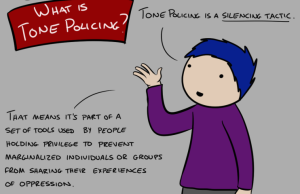After I wrote this article about respecting our transgender loved ones, I received a flurry of e-mails from the parents of trans folks.
The common thread? There are lots of parents out there trying to be supportive, who just want the space to process their feelings about their trans children coming out without hurting anyone – but they aren’t sure where or how to do it.
And I get it. It’s an emotional time. I’ve watched my own parents come to terms with my transition (slowly, but surely). And, as an advocate, I’ve helped guide plenty of loved ones through this process.
I’m not here to tell you that your feelings are wrong or bad – I’m just here to help you figure out the best way to deal with them.
You’re allowed to be scared. You’re allowed to be confused. You’re allowed to be overwhelmed or angry, even. But it’s not your child’s responsibility to make you feel better. It’s your responsibility, as a parent, to put your best foot forward, and take care of yourself so you can better support them.
Whether your child is a young kid, a young adult, or older still, I hope this guide can lay a foundation for healthy processing.
To start, here are four steps you can take to begin unpacking your feelings about your trans child coming out.
1. Start with Journaling
The impulse a lot of parents have is to unload their feelings back onto their transgender child, expecting them to fix things. This is actually detrimental to their child’s well-being, though.
Your child isn’t responsible for your feelings. You are.
I encourage parents to journal with their initial feelings, as it gives them the space to own those feelings without unfairly imposing them on their child.
Here are some questions to consider as you write about this transition:
- What am I afraid of and why? Many parents have a lot of fears around gender transition. Journaling is a great space to acknowledge those fears.
- What do I need help with, and how can I get what I need (without burdening my child)? Clarify where you need support and how you’re going to get that support. And most importantly, be sure to seek out support in ways that don’t put the weight back on your trans child.
- What’s changed? What hasn’t changed? It’s important to remember that while a gender transition can bring a lot of change with it, it doesn’t change everything about your relationship and your child. Put things into perspective with this question.
- What kind of parent do I want to be for my child? What are my values? Set some goals for how you want to support your child through this process. This will help keep you focused on what’s really important.
For more journaling inspiration, I’d encourage parents to read this article where I talk about the common responses loved ones have to transition, and why they react this way. It can offer some important insight while you process!
2. Find a (Trans-Competent) Therapist
Therapists can be a great option if it’s feasible for you.
Therapists can be a huge asset to parents because they create a safe space to process your feelings, as well as working on effective coping strategies and self-education, so that you can move forward confidently and compassionately.
However, you’ll need a therapist who has experience with the transgender community – and sadly, many therapists just don’t measure up.
Psychology Today has a therapist database where you can select keywords like “transgender” (under the “issues” heading on the left side of the page) to help you find what you’re looking for. Therapists will include their phone numbers with the profile, so don’t hesitate to give them a call to learn more.
If a trans-competent therapist is not geographically accessible to you, I’ve also heard great things about Talkspace, which allows you to message or video chat with a therapist wherever you are. Just be sure to mention that you’re looking to be matched with a therapist that has familiarity with transgender identity.
Everyday Feminism (that’s the magazine you’re currently reading!) has a great guide on getting the most out of your therapy experience. Read all about it here.
3. Join a Community
You shouldn’t be doing this alone. And, thankfully, you don’t have to!
For starters, is there a local LGBTQIA+ community center near you? Try typing in the following keyword: “LGBTQIA+ center near [City, State]” into Google.
See what resources come up, like: “Atlanta LGBTQIA+ center, LGBTQIA+ center near Berkeley, CA.” (Note that you might want to try “LGBT” or “LGBTQ” instead.)
If there’s a center in your area, give them a call or stop by. Let them know that you’re the parent of a transgender person looking for support, and see what they have to offer!
There’s also PFLAG! PFLAG is a decades-old organization supporting parents of LGBTQIA+ people. You can learn more about them here. They have chapters throughout the country and are equipped to support parents like yourself.
You can also hop onto Facebook and search for pages and groups for parents of transgender kids. I typed in “parents of transgender” into the search bar, and before I even entered in a noun, tons of pages and groups popped up!
You can try narrowing it down by age as well (“parents of transgender teens” as a search, for example) or see if there are any groups that are local by typing in your city name or your state.
Remember that not every page or group will be what you’re looking for (especially because some of these resources will be “unofficial” or entirely parent-run, rather than founded by an official organization), so if something doesn’t click, don’t give up!
There’s a resource out there for everyone.
4. Keep Educating Yourself
One of the biggest struggles for the parents of transgender folks is trying to learn about their child and the trans community generally.
It can feel overwhelming and even confusing at first. But the cool thing is that there are so many great resources out there that you can access at your own pace. You can begin educating yourself about what it means to be transgender right now.
If you’re not sure where to start, I’m here to help. I personally wrote this transgender 101 guide and, as mentioned before, this article is about the mistakes loved ones often make and why. Both of these are great places to start.
I’d also highly recommend this video on myths about transgender children, particularly if your child is a teen or younger (but it’s a great resource regardless).
Remember that educating yourself is a great avenue for dealing with whatever feelings are coming up from you.
Oftentimes, the anger, sadness, denial, or confusion that parents carry with them can stem from misunderstandings of what it means to be trans. The more effort you put into educating yourself, the more likely you are to accept the feelings you have and work through them.
Putting in that effort is also a great way to show your transgender child that you’re committed to being as informed and supportive of them as possible.
***
From a transgender kid to the parents reading this, I lastly want to thank you for taking this important step to work through your feelings and show up for your child(ren). We need parents like you in this world, standing by us and helping us feel safe and affirmed.
With time, believe me when I say that this gets easier, and it gets much better. When we learn to accept our kids for who they really are, rather than who they’re expected to be, we get the privilege of loving and supporting them unconditionally – helping them to become the happy, whole people they’re meant to be.
[do_widget id=’text-101′]
Sam Dylan Finch is a Contributing Writer at Everyday Feminism. He is a transgender writer, activist, and educator based in the San Francisco Bay Area, exploring the intersections of mental illness and queerness. He is also the founder of Let’s Queer Things Up!, his beautifully queer blog. You can learn more about him here and follow him on Twitter @samdylanfinch. Read his articles here.
Search our 3000+ articles!
Read our articles about:
Our online racial justice training
Used by hundreds of universities, non-profits, and businesses.
Click to learn more





















